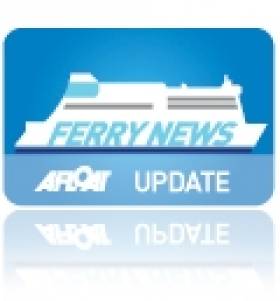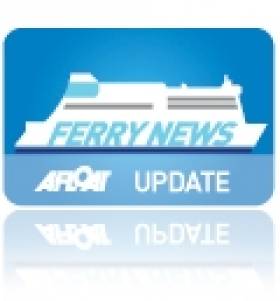Displaying items by tag: Round Island Cruise
Excursionists Enjoy Round Isle of Man Cruise
Around 300 passengers enjoyed spectacular views of the Isle of Man’s coastline on this year’s Ben-my-Chree round-the-island cruise which was held last Saturday following Midsummer's day.
The ropax which the IOM Steam-Packet operates on the route to Heysham, England, departed Douglas at 19:00hrs on the special cruise which first went across the bay towards Onchan Head, swinging back around and continuing south. From there the cruise which included a meal as part of the fare offered further stunning views of Port Erin Bay followed by Peel and its castle.
The fine evening meant that the crew were able to open up Deck 5 to allow passengers to get a great look at the coastline from the vehicle deck. There was also a refurbished motorised horse tram on the deck which made a great vantage point and photo opportunity.
It was an enjoyable evening for all with stunning coastal views, delicious food and musical entertainment from Douglas Town Band’s oompah act, Baron Otto's Blaskapelle, who performed several sets in the ship’s bar throughout the cruise.
Isle of Man Round-The-Island Cruise Rescheduled to Late April
#CruiseRescheduled – A Round-the-Island cruise of the Isle of Man planned for today has been rescheduled to the end of April.
Despite the clocks changing to mark summertime, the unfavourable weather conditions have led to the Isle of Man Steam Packet Company to instead set a new date for the cruise which is on Sunday, April 26th, departing Douglas at 11:30.
All passengers booked on the excursion will be automatically transferred and new tickets will be sent out. Full refunds will be given to those who cannot make the new date.
Commenting on the rescheduling, the company's Chief Executive Mark Woodward said: 'There are some choppy conditions forecast for this weekend, and potentially poor visibility during parts of the cruise, which may restrict views".
"While all of our other services are expected to run as scheduled this weekend, we felt that the forecast wouldn't make for an enjoyable round-the-Island experience for passengers and have therefore rescheduled to allow the trip to be completed in more favourable weather conditions."
All bookings will be automatically transferred or refunds are available on request. Tickets for the new date, cost £24 for adults and £12 for children (15 and under).
To make a booking, visit the Ferry Travel Shop, Sea Terminal, Douglas or call Reservations Team on 661661.
Annual Mid-Summer Round Isle of Man Sunset Cruise
#IsleofManCruise- The annual Round the Island Sunset Cruise is to take place next Saturday (28 June) and operated by the Isle of Man Steam Packet's ro-pax Ben-my-Chree.
The main ship of the Manx ferry company, Ben-My-Chree which was featured in the ferry captain interviews series will depart Douglas at 1900 for a trip of around 4 hours. Tickets are on sale, priced at £26 for adults and £16 for children, including a main meal, non-alcoholic drink and ice cream.
The bar will not be open during the sailing as the vessel is not licenced to sell alcohol while it is in Manx waters. However, passengers are welcome to 'bring their own' to enjoy with their meal.
Chief Executive Mark Woodward said: 'These cruises are a wonderful opportunity to appreciate the beauty of the Manx coastline and enjoy a relaxing evening in good company. They are always popular, so I'd recommend booking early to avoid disappointment.
'Once again this year, the very knowledgeable Captain Stephen Carter will be providing commentary during the journey, which provides a fascinating insight to go with the breathtaking views.
To book a place on the Ben-my-Chree round-the-Island cruise, call in person at the Ferry Travel Shop, Sea Terminal, Douglas or call the Reservations Team on 661661. For more information in general about island ferry connections visit: www.steam-packet.com
































































